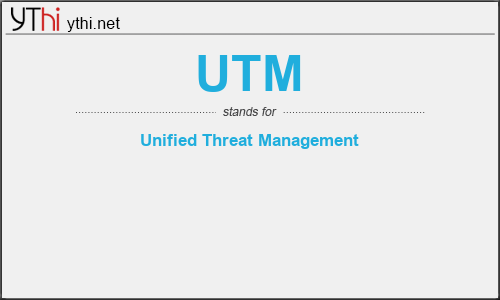What does UTM mean? What is the full form of UTM?
The full form of UTM is Unified Threat Management.
Unified threat management (UTM) is an approach to information security where a single hardware or software installation provides multiple security functions. This contrasts with the traditional method of having point solutions for each security function. UTM simplifies information-security management by providing a single management and reporting point for the security administrator rather than managing multiple products from different vendors.UTM appliances have been gaining popularity since 2009, partly because the all-in-one approach simplifies installation, configuration and maintenance.Such a setup saves time, money and people when compared to the management of multiple security systems. Instead of having several single-function appliances, all needing individual familiarity, attention and support, network administrators can centrally administer their security defenses from one computer. Some of the prominent UTM brands are Fortinet, Sophos, WiJungle, SonicWall and Check Point
Unified threat management, commonly abbreviated as UTM, is an information security term that refers to a single security solution, and usually a single security appliance, that provides multiple security functions at a single point on the network . A UTM appliance will usually include functions such as: antivirus, anti-spyware, anti-spam, network firewalling, intrusion detection and prevention, content filtering and leak prevention. Some units also provide services such as remote routing, network address translation (NAT), and virtual private network (VPN) support. The allure of the solution is based on simplicity, so organizations that may have had individual vendors or appliances for each separate security task can now have them all under one vendor umbrella, supported by one IT team or segment, and run through one console.
A unified threat management (UTM) system is a type of network hardware appliance, virtual appliance or cloud service that protects businesses from security threats in a simplified way by combining and integrating multiple security services and features.
UTM devices are often packaged as network security appliances that can help protect networks against combined security threats, including malware and attacks that simultaneously target separate parts of the network.
UTM cloud services and virtual network appliances are becoming increasingly popular for network security, especially for smaller and medium-sized businesses. They both do away with the need for on-premises network security appliances, yet still provide centralized control and ease of use for building network security defense in depth.
The full form of UTM is Urchin Tracking Module
UTM stands for the Urchin Tracking Module, which is a bit of a mouthful. Urchin was originally a web analytics software, developed by Urchin Software Corporation and designed to track the behavior of unique website visitors. Google bought it in 2005 and the acquisition led to the creation of Google Analytics, which became the most popular web data analytics tool across the internet.
Nowadays, the Urchin Module tagging is an analytics tool used by marketers to track the impact of their online marketing efforts, better understand their audience’s behavior, and measure performance. For instance, UTM tags allow you to discover which channels bring the most sales conversions to your website.
It’s made up of tags (also called modules or variables), which you add to the end of a link, to track and analyze the given page’s traffic sources. When a person clicks on the given link, these parameters are sent back to Google Analytics and will appear in the different Analytics dashboards. The analytics system, therefore, allows you to specifically track where your visitors come from.
The patent-pending Urchin Traffic Monitor (UTM) available in Urchin 4 was specifically designed to provide the most accurate measurements of unique website visitors. For businesses looking to get a deeper understanding of their online visitor behavior, the UTM is an extremely valuable technology that combines the best of client and server side information while letting you control the data. Easy to install, this technology allows business owners to exactly identify unique visitors, click paths, and return loyalty metrics including: first time visitors, returning visitors, and frequency of use.
There are two components to the Urchin Traffic Monitor System: the UTM Sensor, which is a lightweight module installed into the content of the website; and the UTM Engine which is part of the log processing Urchin Engine. The UTM Sensor enables client-side data collection, which is then funneled back through the web server augmenting the normal logfile. The client-side information is combined with the existing server-side data by the UTM Engine to provide a more accurate and complete picture of website activity.
The UTM Sensor is a small amount of JavaScript code that accomplishes two important functions. First, the Sensor negates the effects of caching by forcing at least one hit to progress to the original web server for each pageview. The impact on the server is minimal, and the details about the additional hit are logged into the normal web logfiles resulting in a more complete data set. Secondly, the UTM Sensor uniquely identifies each visitor by using client-side cookies to keep track of first time and returning visitors. This cookie identifier is a communication tag only viewable to your web server in the same nature as session ids. It is not a third party cookie, which provides information outside your system, violating many privacy policies.
UTM
means
Unified Threat Management![]()
Translate Unified Threat Management to other language.


Leave a Reply
You must be logged in to post a comment.